It has been a tough year for the world's business aviation industry. Unable to break free from the worst economic downturn for 70 years, this beleaguered aerospace sector has battled falling aircraft demand, a bloated used aircraft inventory and an unprecedented squeeze on bank lending. These factors have forced manufacturers to make drastic cuts in aircraft production and massive job losses across their plants.
This gloom is illustrated by the most recent General Aviation Manufacturers Association statistics, which recorded a 10% fall in business aircraft shipments for the first six months of 2010 compared with the previous year. The outlook for the next 12 months is equally bleak, says the Teal Group's vice-president, analysis Richard Aboulafia. "We are in a three year downturn and 2011 is the trough," he says.
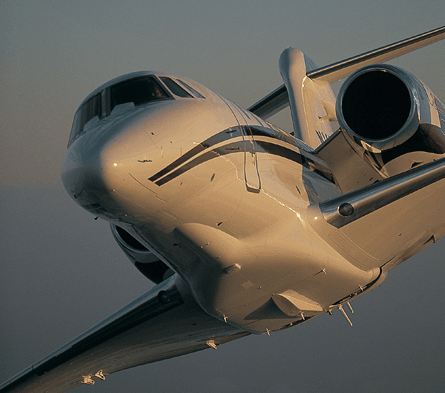 |
|---|
© Cessna |
Flight International's 2010 business aircraft census - compiled using Flightglobal's ACAS business aviation database - reflects the industry's weak performance in the 12 months from 31 August 2009. It reveals the world's active turbine corporate aircraft fleet has climbed by less than 3% to 28,614 jets and turboprops, compared with 27,409 aircraft in 2009.
The business jet fleet has grown by a modest 4% since August 2009, yet the turboprop fleet has remained almost stagnant throughout the census period, rising only 0.3% from 10,725 aircraft to 10,765 units. While the quest for fuel-efficient and understated transport continues, demand for most of these niche aircraft types has fallen significantly over the past 12 months.
 |
|---|
"The impact of the economic recession has been felt most acutely at the lighter end of the business jet spectrum," Aboulafia admits.
"Deliveries in the bottom half of the market declined in 2009 by a remarkable 42.8% by value [excluding very light jets]," he says . "This represents the worst decline of any aerospace market in the present downturn. It was worse than the decline suffered by the majority of world economic markets," he says.
Of course, the lower end of the market has traditionally been dependent on third party finance, which has become increasingly hard to secure since the financial meltdown.
Even banks still willing to lend have tightened their criteria, forcing many potential buyers to delay, postpone or cancel an aircraft purchase. "The numbers of banks have dwindled since 2008 and gone are the days where customers can get a loan without the banks asking searching questions," says Paul Washington, aviation finance manager for SG Equipment Finance.
The lighter end of the marker has also had a greater exposure to the fractional ownership fall out. This sector - once the darling of the business aircraft industry - accounted for a large proportion of light jet sales. When the crisis hit hundreds of owners were forced to sell their shares. NetJets - the largest fractional programme - bought back 500 aircraft alone in the past 18 months - many of which have yet to be resold.
For the makers of light-cabin aircraft, the past 12 months have been brutal.
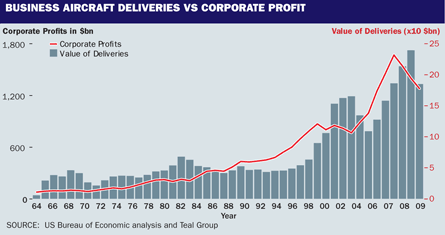 |
|---|
The major players - Bombardier, Cessna and Hawker Beechcraft have bore the brunt of the painful fallout - particularly in North America, where their exposure is greatest. Cessna in September was forced to lay off a further 700 workers - mainly at its Wichita facility - on top of the 8,000 job cuts that have already been made since the downturn hit in 2008. The reason for these losses is evident. In the first six months the airframer delivered only 130 jets and turboprops compared with 194 during the same period in 2009.
Profitability no longer the spur Demand for business aircraft has long been indelibly linked to corporate profitability - when companies made money, manufacturers sold more aircraft. In the current climate these ties have been loosened. Many economies are emerging slowly from the depths of recession and corporate profits are being restored to pre-crisis levels, but the health of the business aircraft manufacturing industry remains fragile. According to the US Bureau of Economic Analysis, second quarter 2010 numbers reveal that US corporate profits are running at an annualised rate of $1.693 trillion since 2001. "It is impossible to state empirically that one type of profit is more conducive to business jet demand than any other," says Richard Aboulafia, senior analyst with US consultancy the Teal Group. "It is notable that manufacturing profits have made the strongest leap of all the business sectors." According to the BEA, US manufacturing profits leaped from $53 billion in 2001 and $48 billion in 2002 to $305 billion in 2006 and $271 billion in 2007. The second quarter numbers have not yet been published, but the first quarter of 2010 saw manufacturing sector results that were nearly in line with the 2006-07 peak. "Since aircraft delivery rate changes typically trail corporate profits changes by 12-24 months, the good news is that we might see a production increase as early as mid-2011. The bad news is that there are serious complications to this rosy outlook," Aboulafia says. "Corporate profits do not resemble the broader economy. Unemployment is still quite high and the economies of the developed world are only growing at an anaemic pace." Most of all, he says, key equities markets have not recovered in line with corporate profits. Healthy profits are not necessarily a sign of the economy's sustainable health, he adds. "Companies are making money because they have slashed costs. The modest increase in consumer and business demand over the past year has benefited increasingly lean and productive companies." |
The decline was attributable entirely to a slump in Citation business jet sales as the delivery tally for Caravan single-engined turboprops rose during the same period from 41 to 56 aircraft. The utility aircraft has been a welcome fillip for Cessna as its appeal has been recognised across all aerospace sectors, including maritime patrol, search and rescue, where budgets are less exposed to economic cycles.
Cessna continues to dominate the business aircraft arena, however, in terms of total inventory, with 5,823 business jets and 545 turboprops recorded in this year's census. The largest gains were made by Mustang entry-level jet. The Mustang fleet climbed by 115 aircraft to 315 over the census period, despite supplier issues earlier in the year. The introduction this year of the CJ4 to the Citation line-up should help to boost Citation numbers further.
Cessna's dominance of the bottom half of the business aircraft market will however, keep it exposed to the economic cycles for some time to come. The airframer is keen to re-enter the large-cabin aircraft arena and has not ruled out relaunching its Columbus business jet when market conditions are right and offering a high- speed competitor to the Gulfstream G650.
Clean- sheet designs are not on the cards for Hawker Beechcraft. It has concentrated on upgrading its product line with its latest model - the entry-level Premier II - set to enter service in 2013. Like Cessna, Hawker Beechcraft has cut its workforce drastically over the past year as demand for its aircraft has fallen. The manufacturer's business jet fleet has climbed by 3% to 2,251 aircraft, including a further 29 950XPs, eight 750s, 13 Premier IA and 39 Hawker 4000s - an 180% increase over last year's total. However, its turboprop fleet has fallen by 59 aircraft since the last census due to the removal from the report of over 160 ageing King Air twins.
The 46-year-old King Air retains its unrivalled dominance of the turboprop market with a fleet of nearly 5,500 aircraft. This ubiquitous type is the backbone of the company's manufacturing empire, representing more than half the world's twin-turboprop fleet and including 610 350 series, 81 B200GTs, 31 350s, 38 B200GTs, 65 C90GT/Is and 184 C90GTs. The latter figure includes the latest GTX, which entered service earlier this year, replacing the three-year-old C90GTi in service.
Bombardier's diverse product line has helped to lessen the impact of the economic crisis on its lower-end business jets. The Canadian airframer grew its inventory over the census period from 3,531 to 3,606. The light/superlight Learjet 40XR and 45XR tallies have climbed by eight and 19 respectively and the midsize Learjet 60XR by 19, as listed by ACAS. Further up the product line the annual tallies increase. The Canadian airframer will hope that the new all-composite Learjet 85 will dominate the midsize cabin arena when it enters service in 2013.
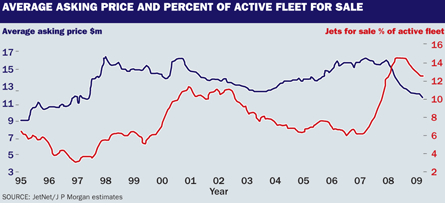 |
|---|
It has already held this accolade in the super-midsize arena with its Challenger 300, which has seen its fleet climb by 37 aircraft to 280 jets since the last census. Other members of the Challenger family have also made impressive gains - the Challenger 850 by 26 and the Challenger 605 by 40 aircraft, bringing Bombardier's total fleet to 122 large-cabin types. At the top of its range, the Global 5000 has seen fleet numbers climb by 18 aircraft to 88 and the XRS by 38 aircraft to 126 of the long-range types.
Bombardier has established itself as a major player at the top of the business jet market. In September it received the thumbs-up from its directors to launch at the NBAA new members of its Global family. The line-up is expected to include a challenger to Gulfstream's ultra-long-range, high-speed G650.
Gulfstream, however, is going full steam ahead with the ultra-long-range aircraft, for which it has more than 200 orders ahead of its service entry next year. The Savannah Georgia-based airframer has seen its in-service fleet jump by around 5% to 1,907 business jets.
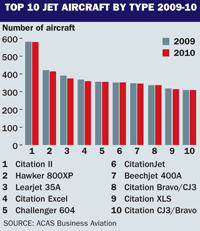 |
|---|
Despite a cut in overall production numbers this year, Gulfstream has seen its in-service business jet fleet jump by 5% from 1,817 to1,907 including a 25% increase in the long-range G550 inventory to 250 aircraft, a 20% increase in the large-cabin 450 fleet and a 7% increase in the G200 tally, to 214 aircraft. The super-midsize aircraft is to be replaced by the G250 next year.
Dassault plans to launch a super-midsize aircraft rival to the G250, Challenger 300 and Hawker 4000, but is tight-lipped about a possible launch date. The French airframer's dominance in the high end of the business jet market has helped it to ride the economic storm - although the journey has been bumpy. The inventory of business jets has nudged up by 78 to 1,751 Falcons, including 85 7X jets - more than double last year's tally of 37 - and 44 2000LX jets, making its census debut this year. Service entry of its long-legged stablemate the 900LX is imminent and the winglet-equipped large-cabin jet will make its census debut next year.
Embraer again has the largest fleet gains, recording a 160% increase in its global inventory to 363 business jets. The jump is attributable to the production ramp-up of the Phenom 100, as the light jet fleet has leapt from 24 to 153 in the census period. The larger light-cabin Phenom 300 makes its census debut with 20 aircraft. Two more Lineage 1000s have been added since the last report and the Legacy 600 - which has had its production halved this year - has nudged ahead by 17 aircraft.
The new longer-range Legacy 650 is expected to enter service later this year as a rival to well-established designs, including the G350, 2000LX and Challenger 605. Meanwhile, Embraer is maintaining schedules for its new mid-range product offerings in the hope that the market will be in recovery. The larger Legacy 500 - the fifth business jet in its portfolio - is earmarked for service entry in the second half of 2012, a year ahead of its mid-light Legacy 450.
At the top end of the business jet market, Airbus and Boeing have continued to expand their fleets of VIP-configured airliners, but the past 12 months have bought mixed results. Boeing's BBJ, BBJ2 and BBJ3 inventory has climbed by a modest five aircraft and its 777 tally by two. The cargo-door equipped BBJC makes its census debut with a single unit.
Although deliveries are expected to pick up this year, market conditions have been tough for Boeing, which suffered cancellations and deferrals from its high-end customers. In contrast, Airbus, which has had few deferrals and cancellations, has seen its tally increase by 20 to 107 corporate airliners. The A318 Elite fleet climbed by 40% to 12, the single-aisle A319 Airbus Corporate Jetliners fleet by eight and the twin-aisle A340 fleet by two. Airbus is increasing its marketing activity within Asia Pacific, notably in China, where it forecasts a demand for around five 15-plus-seat VIP aircraft a year.
GLOBAL MARKETS
Airframers' reliance on the global marketplace to boost their orderbooks is as prevalent now as ever. Without exception, the markets outside North American make up more than 50% of orders for the manufacturers and it is not hard to see why this focus has shifted. The painful economic downturn in North America and the USA in particular has wreaked havoc on the continent's business aircraft inventory over the past 12 months.
ACAS lists the installed base has nudging forward by 1.9% during the census period - the slowest growth of any of the world regions - as individuals and companies tighten their belts and wait for the fragile economy to grow. The USA is home to the largest installed base of business jets and turboprops with 11,490 and 7,095, respectively, and is unlikely to be toppled from this number one spot any time soon.
 |
|---|
This cannot be said for Europe, however. Still home to the second largest concentration of business aircraft, the continent's exposure to the economic fall-out has had an effect on the this year's tally. ACAS reveals that the fleet has grown by just over 3% to 3,835 business jets and turboprops. The bulk of this growth is recorded in Russia and Austria - with gains of 13 and 26 business jets respectively.
Portugal - home to NetJets Europe - saw its tally fall by over 25 aircraft since the last census as the fractional provider removed unwanted mainly light-cabin business jets from its fleet due to changing customer circumstances.
Snapping at Europe's heels for second place is Latin America. This thriving region has seen its installed base climb in the census period by 356 jets and turboprops to 3,331 aircraft, reveals ACAS. This 12% climb is almost entirely due to the bullish economies of Argentina, Brazil and Mexico, which is driving demand for these flexible forms of transport. Argentina saw its tally leap by 20% to 110 jets and 112 turboprops. Brazil - home to the largest installed base of business aircraft in Latin America - saw its fleet climb by 104 jets and 66 turboprops. Meanwhile, Mexico - which houses the continent's largest business jet fleet - saw its tally climb by 55 to 606 jets and 271 turboprops.
The Pacific Rim has also made strides over the past 12 months. ACAS lists the fleet rise as more than 11%, to 501 jets and 416 turboprops. Australia has emerged over the past 12 months as a dominant player in the region, making gains of 11 jets and 11 turboprops respectively bringing its total fleet to 333 aircraft.
China has made the largest gains, recording a 20% increase in its business jet tally to 142 aircraft. The world's airframers expect the market to grow at an even greater pace as the country's economy continues to boom, regulations become more relaxed and the military loosens its grip on the nation's airspace.
The Middle Eastern fleet has also progressed over the past 12 month with much of the growth coming from sales of large-cabin business jets and airliners. ACAS data reveals a climb of 44 jets and six turboprops, with the major gains recorded in the United Arab Emirates - 102 to 118 jets and turboprops - and Saudi Arabia, with 16 jets and six turboprops.
The past 12 months have not been entirely smooth, however, says ExecuJet Middle East managing director Mike Berry. "The downturn impacted us later than most other economies. Aircraft sales have fallen and the charter and management business has become increasingly competitive as there are fewer aircraft available. But it will always be a prominent market for business aviation due to the high volumes of high-net-worth individuals."
LONG-RANGE AIRCRAFT ARE SWEET SPOT
Used aircraft inventories remain stubbornly high. Around 13% of the global business aircraft fleet is for sale - well above the industry average of around 10%. "As a rule of thumb, when the inventory dips below this mark, it is typically a sellers' market and when it goes above 10% it is a buyers' market," says Oliver Stone, executive director, Business Air International.
The older-generation types are providing harder to shift - notably the light-cabin Cessna Citation II and Bombardier Learjet 35A. These aircraft types are listed in the Flightglobal ACAS database as the top two most common business jets, with fleets of 579 and 374 aircraft respectively.
"The Citation II is the bread and butter of the business aviation industry," says JetBrokers Europe chief executive Tim Barber, "but there is 25% of the global stock on the market today - enough stock to fulfil the current sales demand for the next two years."
Even overhauling the engine to extend the lifespan of the aircraft has been ruled out, says Barber, as this can cost around half the price of the aircraft. "A used CII, for example, is valued at around $1.2 million, but the overhaul will cost over $600,000."
Consequently, there has been "a flurry of activity" on the used engine market as owners trade powerplants in an effort to enhance the life and appeal of their aircraft.
"There is still significant supply of these aircraft. So much so that at the current rate of sales there is enough inventory for the next two and a half years," says Barber.
To control the size and cost of their used aircraft inventories, some airframers try to keep track of each aircraft that is put up for sale and offer sellers incentives to boost the aircraft's appeal to a future buyer. "We tend to know when one of our TBMs is up for sale," says Daher Socata. "So we will offer the customer a free service, for example, and one of our service centres. This will make the asset more attractive to a buyer and keep the price higher."
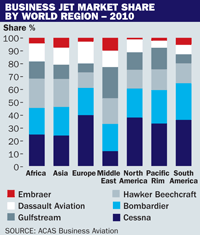 |
|---|
The cost of an "average" 2007 model TBM 850, for example, has fallen from $2.4 million in the second quarter of 2009 to $2.1 million in the third quarter of 2010.
"In the business turboprop sector, prices have bottomed out and the sales inventory has remained steady throughout the year."
The bulk of activity over the past few months has been focused at the high end of the market. Barber says: "There is a huge difference in demand for top-end rather than bottom-end aircraft. An average 2008 Gulfstream G550, for example, priced at $39 million in the second quarter of 2009, was worth $43 million in the third quarter of 2010. A similarly aged Global XRS will have climbed in value from $39 million to $41 million during the same period," he says.
Barber sounds a note of caution. "While buyers are starting to return, most are looking for a bargain and will hold out for a purchase," he says. "Deals continue to fall through because of unnecessary haggling, sometimes over the most minor issues."
This view is echoed by Stone, who says: "The people who really needed to sell their aircraft have already done so. Many sellers are waiting for the market to pick up and won't sell at any price now. Every once in a while a forced sale or two will come along and this will reset aircraft values."
Source: Flight International




















